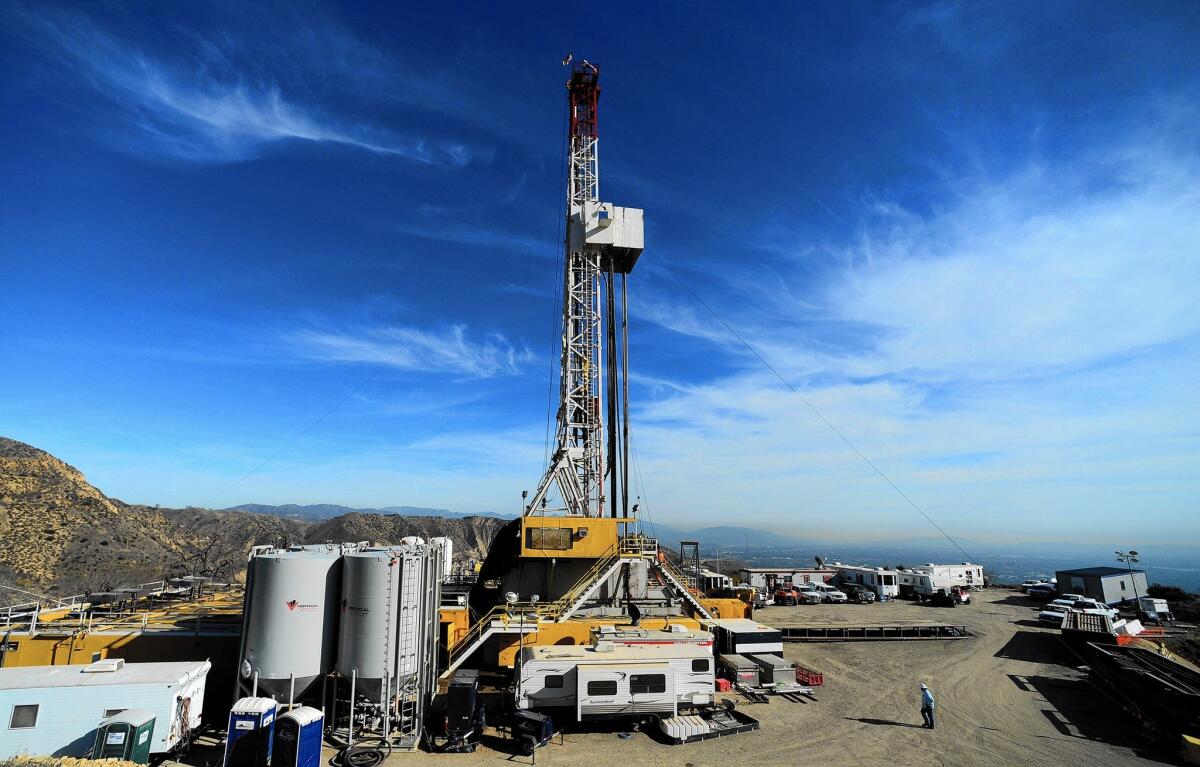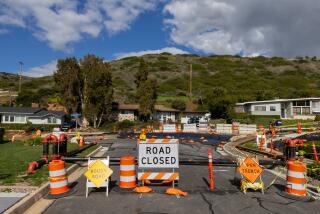Claims in Porter Ranch gas leak could cost utility billions of dollars

With ailing residents, displaced neighborhoods and a potential decline in property values, the leak at Southern California Gas Co.’s Aliso Canyon storage facility could cost the utility billions of dollars, some legal experts say.
So far, the gas company has spent more than $50 million combating the leak that began Oct. 23, according to a securities filing Thursday. More than 25 lawsuits have been lodged against the utility; “the cost of defending the lawsuits, and any damages, if awarded, could be significant,” the filing stated.
The utility has told the U.S. Securities and Exchange Commission that it had “at least four types of insurance policies that it believes will cover many of the current and expected claims, losses and litigation … associated with the natural gas leak at Aliso Canyon,” which has forced thousands of people from their homes. Those policies, the utility said, have a combined limit available “in excess of $1 billion.”
But legal experts and lawyers for residents in the Porter Ranch community near the natural gas storage facility argue that $1 billion might not come close to what the utility will need.
Part of the reason, they say, is that the company has yet to plug the gas leak.
Even the devastating 2010 Pacific Gas & Electric natural gas pipeline explosion in the Bay Area city of San Bruno, which killed eight people, didn’t have the ongoing hazard that Aliso Canyon does. That explosion has cost PG&E more than $2 billion in penalties, with the cost of litigation continuing to mount.
“I’m unaware of anything of this magnitude that has happened before,” said Brian Panish, an attorney for some of the homeowners. “There’s no study to know what the long-term effects are. What about some of these children? Do you think people’s homes are going to be worth the same?”
The Los Angeles utility is a subsidiary of San Diego’s Sempra Energy, which has seen its stock price fall more than 15% since the leak was discovered at the facility in the northern part of the San Fernando Valley.
Most Wall street analysts that follow the stock have a “buy” recommendation on Sempra, which also is the parent of San Diego Gas & Electric. But some say they are reviewing the leak’s financial impact for possible updates to their stock opinions.
Even after recruiting several of the world’s leading experts to stop the leak, Southern California Gas’ efforts have faltered. The company began drilling a relief well to help stop the leak but that is expected to take three to four months.
The utility says it does not believe it is possible at this time “to accurately measure the amount of natural gas being lost from the leak.”

A Porter Ranch resident describes her family’s experience as they relocate from their home during the holidays. A massive natural gas leak has sickened residents in the area since October.
In the meantime, the site of the leak, about a mile from the closest homes, forced the utility to relocate thousands of families through the holidays to hotels as winds caused fumes to waft through neighborhoods. Residents complained of respiratory problems, headaches, nausea, nosebleeds and other short-term ailments. Health officials have said the fumes pose no serious long-term health risks.
Aliso Canyon is one of four such storage facilities the utility operates. The company says its Playa del Rey natural gas storage facility is the only other one that sits close to homes.
Southern California Gas declined to talk about its liability because of the pending lawsuits. The utility prefers to focus on what it is doing to reduce the adverse impact the leak is having on neighborhoods.
“We are working with families who want to move to temporary accommodations until the leak is stopped, and we’ve also established a claims process for anyone who feels they’ve suffered harm or injury as a result of this incident,” said Trisha Muse, a utility spokeswoman.
Loretta Lynch, a lawyer and former president of the California Public Utilities Commission, said the gas company ultimately will have to respond to two sets of issues: its responsibility as a regulated utility under California law and its liability for damages as determined by the courts as a result of pending lawsuits.
Under state law, Lynch said, utilities are required to provide adequate and safe service to customers at a reasonable cost. The Aliso Canyon leak coupled with the ongoing inability to stop it raises questions about how the gas company is performing its job.
“I think the utility has failed in its central duty,” Lynch said.
The gas company is likely to argue that the state standards are poor or insufficient, which could be a winning position before the PUC, she said. The best recourse for consumers may be to sue the utility, Lynch said.
“These homeowners are going to go through the very painful dance of tort liability,” Lynch said. “Both as a lawyer and a former PUC president, I believe these homeowners will get better justice from the courts than this PUC.”
When determining a utility’s responsibility in cases such as the Aliso Canyon gas leak, the PUC in general reviews whether the utility gave proper notification about the problem and performed regular maintenance of the facility. In addition, the commission assesses the cost of the problem — an expense that usually is borne largely by ratepayers rather than company shareholders.
The PUC can issue fines of up to $50,000 per violation per day for violations of the California Public Utilities Code, CPUC General Orders and the Federal Code of Regulation involving safety in natural gas transmission and distribution, commission spokeswoman Terrie Prosper said. State law requires that those funds be deposited into the California general fund.
Prosper said the PUC can order additional penalties, such as refunds of ratepayer costs through their energy bills. There is no cap on additional penalties, and they vary by case.
The commission, however, “does not get involved in civil litigation and any compensation that a utility may pay directly to the impacted members of a local community,” Prosper said.
In April, the current five-member PUC issued a record $1.6-billion fine against PG&E for the San Bruno pipeline explosion.
Browne Greene, a former president of the California Trial Lawyers Assn., said he believes that Southern California Gas is looking at significant penalties for the ongoing leak.
“I would think that they would be looking at a huge fine in terms of endangering the public,” said Greene, who has practiced law for some 50 years. But that’s where he and others believe that compensation from the PUC for residents harmed by the leak will largely end.
“I think effectively they’re much more lenient toward SoCal Gas and any of these other utilities that are dealing with them all the time,” Greene said.
That leaves residents to battle the utilities in court.
“If you really want to hold people accountable and you want to get to the truth and you want to avoid the politics of regulators, you’ve got to use the court system,” said Frank Pitre, a lawyer who represented residents in the San Bruno gas pipeline explosion and is representing some Porter Ranch residents.
Pitre declined to put a figure on the harm that the Aliso Canyon leak is causing. But where the San Bruno explosion was a single incident that led to hundreds of millions of dollars in damages, Aliso Canyon continues with unknown issues of health and safety, he said.
“Every case is unique,” Pitre said. “In the PG&E case, there were people who were killed. There were people whose homes were destroyed. Those are perhaps different damages than, say, Porter Ranch.”
Join the conversation on Facebook >>
Of the likelihood that there will be loss in property value, “there’s simply no question,” said Randall Bell, chief executive of Landmark Research Group, who specializes in real estate damages. “Porter Ranch has been in the news so much, potential buyers are going to be aware of that.”
“Having worked on these cases all over the country and all over the world, really, if I were a property owner there, I would be very concerned,” Bell said.
The gas company’s $1 billion in insurance may end up looking more like a floor than a ceiling, Panish and Greene said.
“This would be promising because it looks like there’s a lot of insurance,” Greene said. “But there’s a deeper pocket … the gas company behind it.”
Twitter: @ivanlpenn
ALSO
Brown declares state of emergency at Porter Ranch amid massive gas leak
‘This has never happened before.’ Powerball jackpot swells to $700 million
Monster waves batter California coast as latest El Niño storm passes through
More to Read
Inside the business of entertainment
The Wide Shot brings you news, analysis and insights on everything from streaming wars to production — and what it all means for the future.
You may occasionally receive promotional content from the Los Angeles Times.











